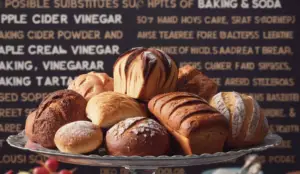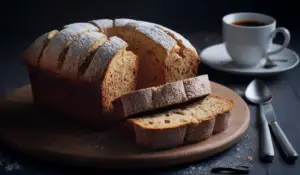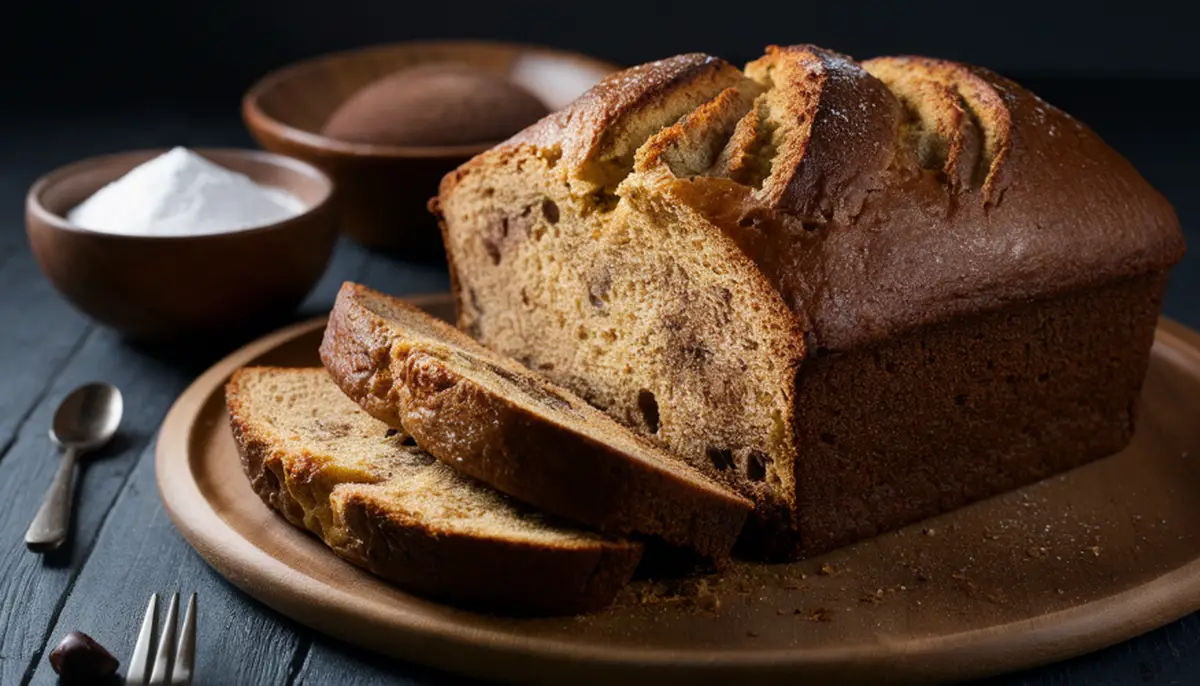Introduction: Understanding Baking Soda in Bread Baking
Baking soda, or sodium bicarbonate, is a common leavening agent used in various types of bread and baked goods. It plays a crucial role in ensuring that your bread rises properly, creating the light and airy texture that we all love. But what happens when you run out of baking soda, or perhaps you’re looking for a more natural alternative? Don’t worry; there are several substitutes you can use that will still give your bread the rise it needs.
In this article, we’ll explore some of the most effective substitutes for baking soda in bread, diving deep into the science behind each one, and how to use them for the best results. Whether you’re baking a quick loaf for breakfast or preparing a special treat, this guide will ensure that your bread turns out just as delicious without baking soda.
The Role of Baking Soda in Bread

What Does Baking Soda Do?
Baking soda is an alkaline compound that reacts with acidic ingredients in the dough, such as buttermilk, yogurt, or vinegar, to produce carbon dioxide gas. This gas gets trapped in the dough, causing it to expand and rise. The result is a lighter, fluffier bread with a tender crumb.
Why Might You Need a Substitute?
There are several reasons why you might need a substitute for baking soda in your bread recipe. Perhaps you’ve run out of it, you’re looking for a more natural or healthier alternative, or maybe you’re experimenting with different ingredients to achieve unique flavors and textures in your bread.
Common Scenarios Where Baking Soda Substitutes Are Needed
- Allergies or Sensitivities: Some individuals may be sensitive to baking soda, experiencing discomfort or adverse reactions when consuming products that contain it.
- Dietary Preferences: Those following certain dietary guidelines may seek alternatives that align better with their nutritional goals.
- Ingredient Availability: In some regions or during certain times, baking soda may be difficult to find, necessitating the use of substitutes.
Best Substitutes for Baking Soda in Bread
1. Baking Powder
What Is Baking Powder?
Baking powder is a mixture of baking soda, cream of tartar (an acid), and a moisture absorber like cornstarch. It is a common leavening agent used in recipes where no additional acidic ingredient is present.
How to Use Baking Powder as a Substitute
To replace baking soda with baking powder, you’ll need to use more baking powder—about three times the amount of baking soda your recipe calls for. For example, if a recipe requires 1 teaspoon of baking soda, use 3 teaspoons of baking powder instead.
Benefits and Drawbacks
- Benefits: Baking powder is widely available and easy to use. It’s also a straightforward substitution.
- Drawbacks: Baking powder contains additional ingredients like cream of tartar and cornstarch, which may slightly alter the taste and texture of the bread.
2. Potassium Bicarbonate
What Is Potassium Bicarbonate?
Potassium bicarbonate is a chemical compound similar to baking soda but without the sodium. It’s often used as a low-sodium alternative in baking.
How to Use Potassium Bicarbonate
You can substitute potassium bicarbonate for baking soda in a 1:1 ratio. However, since potassium bicarbonate lacks the salty taste of baking soda, you may want to add a pinch of salt to your recipe.
Health Benefits
- Health Considerations: Potassium bicarbonate is a great option for those watching their sodium intake, such as individuals with hypertension or heart disease.
3. Self-Rising Flour
What Is Self-Rising Flour?
Self-rising flour is a blend of all-purpose flour, baking powder, and salt. It’s commonly used in recipes that require a quick rise, like biscuits or pancakes.
How to Use Self-Rising Flour
To use self-rising flour as a substitute for baking soda, simply replace the flour in your recipe with self-rising flour, and omit any additional baking soda or salt.
When It Works Best
- Best Uses: Self-rising flour is best for recipes that require a mild leavening effect, such as quick breads and scones. It may not be ideal for more robust bread recipes.
4. Yeast
What Is Yeast?
Yeast is a living organism that ferments sugars, producing carbon dioxide and alcohol. This fermentation process causes the dough to rise, making it a traditional leavening agent in bread baking.
How to Use Yeast as a Substitute
To replace baking soda with yeast, dissolve the yeast in a warm liquid (water or milk) and add it to the dough. You’ll need to allow time for the dough to rise, which can range from 30 minutes to several hours, depending on the recipe.
Pros and Cons
- Pros: Yeast imparts a rich flavor and a chewy texture to bread. It’s also the go-to leavening agent for traditional bread recipes.
- Cons: Using yeast requires more time and precision. It also may not be suitable for quick bread recipes that don’t allow time for rising.
5. Buttermilk
What Is Buttermilk?
Buttermilk is a fermented dairy product with a tangy flavor. It’s acidic, which makes it a good partner for baking soda in recipes. However, it can also work as a leavening agent when paired with an alkaline compound like potassium bicarbonate.
How to Use Buttermilk as a Substitute
When using buttermilk as a substitute for baking soda, you’ll need to reduce the amount of liquid in your recipe to account for the added buttermilk. For example, if your recipe calls for 1 cup of milk, replace it with 1 cup of buttermilk and reduce the other liquids by 1/4 cup.
Culinary Benefits
- Flavor Enhancement: Buttermilk adds a pleasant tang and richness to bread, enhancing its overall flavor profile.
6. Lemon Juice

What Is Lemon Juice?
Lemon juice is a natural acid that can be used as a leavening agent when combined with an alkaline substance.
How to Use Lemon Juice
To substitute lemon juice for baking soda, combine it with an alkaline compound like baking powder or potassium bicarbonate. Use about 1/2 teaspoon of lemon juice for every teaspoon of baking soda, adjusting the liquid content of your recipe accordingly.
Considerations
- Flavor Impact: Lemon juice adds a subtle citrus flavor to bread, which can be delightful in certain recipes but may not be suitable for all.
7. Vinegar
What Is Vinegar?
Vinegar is an acidic liquid made from fermented ethanol. It’s commonly used in baking to react with baking soda and produce a leavening effect.
How to Use Vinegar as a Substitute
Mix 1 teaspoon of vinegar with 1/4 teaspoon of baking powder to replace 1 teaspoon of baking soda in your bread recipe. This combination will provide the necessary acid-base reaction to leaven the dough.
Types of Vinegar to Use
- White Vinegar: A neutral option that won’t affect the flavor of your bread.
- Apple Cider Vinegar: Adds a slight apple flavor, which can be pleasant in certain types of bread.
8. Cream of Tartar
What Is Cream of Tartar?
Cream of tartar is a byproduct of winemaking, consisting of potassium bitartrate. It’s often used as a stabilizing agent in baking.
How to Use Cream of Tartar
Combine 1/4 teaspoon of baking powder with 1/4 teaspoon of cream of tartar to substitute 1 teaspoon of baking soda. This mixture will provide the acidity needed for leavening.
Benefits
- Stabilizing Properties: Cream of tartar helps to stabilize egg whites and whipped cream, making it a versatile ingredient in baking beyond just a baking soda substitute.
The Science Behind Leavening Agents
How Leavening Agents Work
Leavening agents like baking soda, baking powder, and yeast work by producing gas bubbles within the dough or batter. These bubbles expand when heated, causing the dough to rise. The choice of leavening agent depends on the desired texture, flavor, and rise of the final product.
Acid-Base Reactions
Baking soda requires an acid to activate its leavening properties. When combined with an acid, it produces carbon dioxide gas, which gets trapped in the dough, creating a rise. This is why baking soda is often paired with ingredients like buttermilk, yogurt, or vinegar.
Yeast Fermentation
Unlike chemical leavening agents, yeast works through fermentation. It feeds on the sugars in the dough, producing carbon dioxide and alcohol as byproducts. This process not only leavens the dough but also develops complex flavors.
The Role of Temperature
Temperature plays a crucial role in the effectiveness of leavening agents. For instance, yeast requires a warm environment to activate, while baking powder reacts quickly at room temperature. Understanding these nuances can help you achieve the perfect rise in your bread.
Health and Nutritional Insights
Sodium Content
Baking soda contains sodium, which can contribute to high blood pressure and other health issues when consumed in excess. Substituting baking soda with potassium bicarbonate or other low-sodium alternatives can make your bread healthier, especially for those on a low-sodium diet.
Allergies and Sensitivities
Some individuals may have allergies or sensitivities to certain leavening agents, such as baking soda or cream of tartar. It’s essential to know your options and choose substitutes that align with your dietary needs.
Digestive Health
Certain leavening agents, like yeast, can have positive effects on digestive health. Yeast-fermented bread, for example, may be easier to digest and could offer probiotics that support gut health.
Nutrient Retention
The choice of leavening agent can also affect the nutrient content of your bread. For instance, using whole ingredients like buttermilk or yogurt can add vitamins and minerals to your bread, enhancing its nutritional value.
Cultural and Regional Variations
Traditional Breads Without Baking Soda
In many cultures, traditional bread recipes do not require baking soda. For example, sourdough bread relies on natural yeast fermentation, while Indian naan bread often uses yogurt or buttermilk as a leavening agent. Exploring these regional variations can offer new insights and inspiration for your baking.
Cultural Significance of Yeast
Yeast has been a staple in bread baking for centuries, particularly in European and Middle Eastern cuisines. The art of bread-making with yeast is often passed down through generations, carrying with it cultural traditions and family recipes.
Global Alternatives to Baking Soda
In different parts of the world, bakers use various alternatives to baking soda. For instance, in some African and Caribbean cultures, cassava flour is used to make naturally leavened bread, while in East Asia, rice flour and natural fermentation are common.
Practical Tips for Baking Without Baking Soda
Adjusting the Recipe
When substituting baking soda, it’s essential to adjust the other ingredients in your recipe to maintain the right balance of flavors and textures. For example, if you’re using buttermilk, you may need to reduce other liquids in the recipe.
Testing Your Dough
Before baking, it’s a good idea to test your dough’s rise by letting it sit for a few minutes. This can help you gauge whether your substitute is working effectively and whether additional adjustments are needed.
Flavor Considerations
Different substitutes can impart unique flavors to your bread. For instance, buttermilk adds a tangy taste, while yeast contributes a rich, fermented flavor. Consider how these flavors will complement the other ingredients in your bread.
Frequently Asked Questions (FAQs)
Can I Use Baking Powder Instead of Baking Soda in All Recipes?
While baking powder can be used as a substitute for baking soda, it’s not a perfect match for all recipes. Baking powder contains acid, which can alter the flavor and texture of your bread. It’s best to use it in recipes where the acidic component will complement the other ingredients.
What Happens if I Use Yeast Instead of Baking Soda?
Using yeast instead of baking soda will change the texture and flavor of your bread. Yeast-fermented bread has a chewier texture and a richer, more complex flavor. However, yeast requires more time to rise, so you’ll need to adjust your baking process accordingly.
Is It Safe to Use Potassium Bicarbonate as a Substitute?
Yes, potassium bicarbonate is safe to use as a substitute for baking soda. It’s especially beneficial for those on a low-sodium diet. However, because it lacks the salty taste of baking soda, you may want to add a pinch of salt to your recipe to balance the flavors.
Can I Make Bread Without Any Leavening Agent?
Yes, it’s possible to make bread without any leavening agent, though the texture will be much denser. Flatbreads, such as tortillas and matzo, are examples of breads made without leavening agents. These breads have a unique texture and are often used in specific cultural or culinary contexts.
How Do I Know Which Substitute to Use?
The best substitute for baking soda depends on the specific recipe and the desired outcome. Consider the flavor, texture, and rise you want to achieve, and choose a substitute that complements the other ingredients in your bread.
Conclusion: The Art of Baking Without Baking Soda
Baking without baking soda can be a rewarding challenge that opens up new possibilities in the kitchen. Whether you’re using baking powder, yeast, buttermilk, or another substitute, understanding the role of each ingredient will help you achieve delicious results. Experiment with different substitutes to find the perfect match for your bread recipes, and don’t be afraid to explore traditional and cultural variations that offer a new twist on classic baking techniques.

